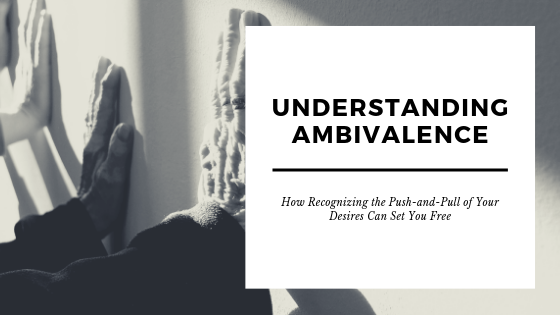Think of the last difficult decision you had to make. Maybe it was as simple as where you’d like to go out to eat or as significant as a change in career path. What makes the decision difficult is the tension between the options: you might desire some more than others, or fear the downside if you make the wrong decision. Eventually, the choice is made when one benefit outweighs the other and you feel confident enough moving forward.
But what happens when you get stuck between two desires? Or worse yet, when you feel two opposing emotions about something at the same time? Have you experienced loving someone and hating them in the same instant? What about wanting closeness and intimacy, but pushing others away by your actions or words?
In these examples, what you’re experiencing is a phenomenon called ambivalence.
What is ambivalence?
Ambivalence is often thought of as apathy or indifference, meaning you don’t care much about something or that it doesn’t matter to you. On the contrary, ambivalence involves strong desires or emotions in opposition to one another. You may feel pulled in two different directions at the same time, or you might flip-flop back and forth between two feelings. This can take place in both simple decisions (where should we go for dinner?) as well as major desires (is this the person I want to marry?).
As time passes and you struggle to resolve these opposing emotions, you might find that you do experience a form of apathy. The indifference is a numbing response to exhaustion from the tension of trying to balance both sides at once.
What in my story might cause ambivalence?
Ambivalence is common for survivors of sexual abuse or assault as they deal with the aftermath of their abuse. In many cases, the abuser is someone with whom the survivor has a close relationship. Positive memories and experiences with that person get mixed up with the abuse, and the confusion of feeling drastically different emotions toward the abuser can be overwhelming. The survivor may also struggle with aspects of sexual abuse that felt good when they confront the damage it has done in their lives.
Similarly, many partners of sex addicts experience the addict’s behaviors as a sexual violation against the partner. Confusion around staying in the relationship to work things out or leaving is common as they try to reconcile the person they love with the addiction that has destroyed their relationship.
For addicts, shame is a major factor in ambivalence. Addicts live a double life, attempting to balance the addictive thoughts and behaviors with the normal, everyday self. Breaking off into these two versions of the self helps to ignore or deny the tension of ambivalence around the double life.
Ambivalence can appear in depression and anxiety as well. If you’re anxious, you may hate being alone but feel terrified of breaking into a group or connecting with others. In depression, ambivalence can appear when you lack the motivation and energy for self-care and yet know that the way to feel better is through exercising, spending time with loved ones, or other activities to take care of yourself.
How can I recognize my ambivalence?
One common characteristic of ambivalence is all-or-nothing or black-and-white thinking patterns. The rigidity of thought patterns requiring a choice between two extremes is what makes the tension between them feel so difficult. Sitting in the gray area of wanting two things equally and being unsure of what the right next step is can be stressful. Often, that leads to a desire to escape.
That desire to escape is where apathy and numbness come in. When alternating back and forth between the two desires or emotions becomes too much, you feel defeated by the struggle. Rather than staying with the tension, you might just throw in the towel and numb out with addiction or distraction.
How can I deal with my ambivalence?
Acknowledge that there are gray areas. Instead of the rigidity of black-and-white or all-or-nothing thinking, allow yourself to recognize that you can (and are!) feeling or desiring two seemingly opposite things at the same time.
Press into that knowledge and explore your ambivalence with God and others. Talk about it with a therapist or trusted friend and explore what might be coming up with each of the desires.
As a Christian, ambivalence leads to greater intimacy with God. So many Psalms contain ambivalence: lament, pain, and crying out to God; followed by reminders of the goodness of God and his character. Often the Christian life involves suffering while also seeking to place hope in God.
Name your desires, even if it hurts to put words to them. The naming of desires is painful because it involves grief, in understanding that your desires aren’t met yet and you may never see those desires realized. But recognizing and working through that grief leads to life rather than numbing or escapism. Addicts in particular struggle to know their true desires, as addiction has offered immediate relief or numbing from desires in the past. In owning and acknowledging desires, addicts receive freedom to seek out other ways to meet that need instead of through addictive behaviors.
Learn to practice acceptance. Acceptance isn’t settling for the status quo or pretending that things are okay when they really aren’t. Instead, acceptance involves recognizing the reality of where you are right now in this present moment, and reminding yourself that you’re okay. If you aren’t satisfied with what you’re experiencing in the present, acceptance invites you to explore what you might like to change in the future. Accepting your ambivalence helps you to begin to be curious about it and seek out the story behind your ambivalence. Understanding your story opens you up to change.


